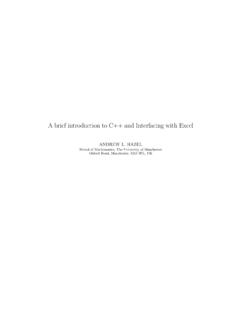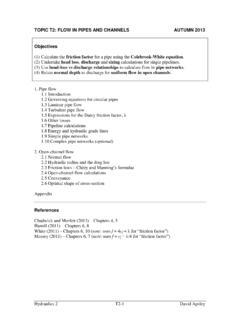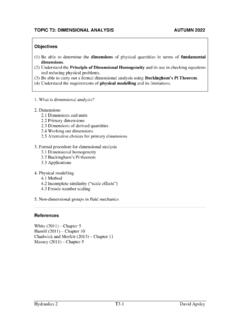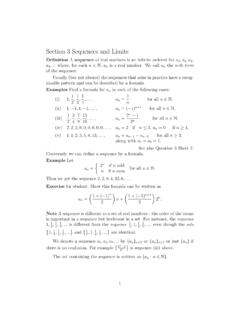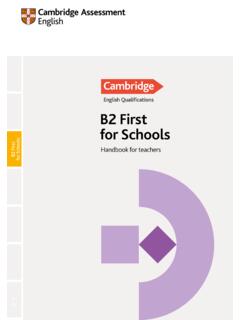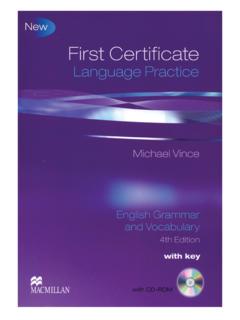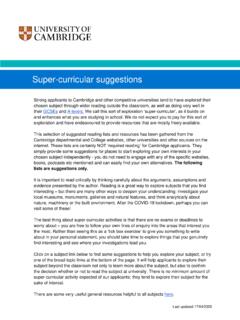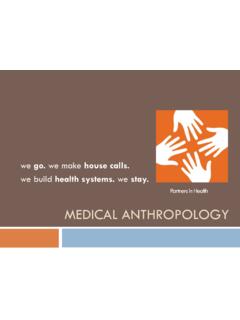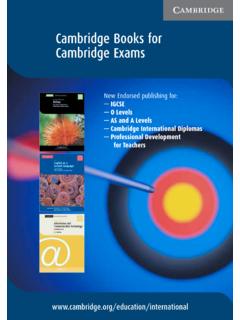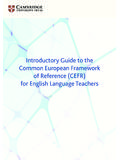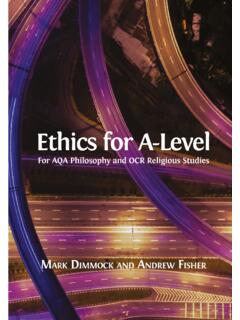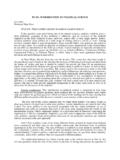Transcription of MATH20142 Complex Analysis - University of Manchester
1 MATH20142 Complex AnalysisDr Charles WalkdenDepartment of MathematicsThe University of Manchester26thFebruary, 2020 MATH20142 Complex AnalysisContentsContents0 Preliminaries21 Introduction52 Limits and differentiation in the Complex plane and the Cauchy-Riemannequations113 Power series and elementary analytic functions224 Complex integration and Cauchy s Theorem375 Cauchy s Integral Formula and Taylor s Theorem586 Laurent series and singularities667 Cauchy s Residue Theorem758 Solutions to Part 1999 Solutions to Part 210210 Solutions to Part 311011 Solutions to Part 411912 Solutions to Part 512713 Solutions to
2 Part 613014 Solutions to Part 7135c University of Manchester 20201 MATH20142 Complex Analysis0. Preliminaries0. Preliminaries Contact detailsThe lecturer is Dr. Charles Walkden, Room , Tel: 0161 275 5805, office hour is: Monday 10am 11am. If you want to see me at another time thenplease email me first to arrange a mutually convenient time. Course structure Learning outcomesAt the end of the course you will be able to prove the Cauchy-Riemann Theorem and its converse and use them to decide whethera given function is holomorphic; use power series to define a holomorphic function and calculate its radius of conver-gence; define and perform computations with elementary holomorphic functions such as sin,cos, sinh, cosh, exp, log, and functions defined by power series.
3 Define the Complex integral and use a variety of methods (the Fundamental Theoremof Contour Integration, Cauchy s Theorem, the GeneralisedCauchy Theorem and theCauchy Residue Theorem) to calculate the Complex integral of a given function; use Taylor s Theorem and Laurent s Theorem to expand a holomorphic function interms of power series on a disc and Laurent series on an annulus, respectively; identify the location and nature of a singularity of a function and, in the case of poles,calculate the order and the residue; apply techniques from Complex Analysis to deduce results inother areas of mathemat-ics, including proving the Fundamental Theorem of Algebra and calculating infinitereal integrals, trigonometric integrals, and the summation of series.
4 LecturesThere will be approximately 21 lectures in lecture notes are available on the course webpage. The course webpage is availablevia Blackboard or directly let me know of any mistakes or typos that you find in the will use the visualiser for the majority of the lectures. Each week, I will upload scannedcopies of what I write on the visualiser onto the course University of Manchester 20202 MATH20142 Complex Analysis0. PreliminariesThe lectures will be recorded via the University s LectureCapture (podcast) that Lecture Capture is a useful revision tool but it is not a substitute forattending lectures.
5 The support classes are not podcasted. ExercisesThe lecture notes also contain the exercises (at the end of each section). The exercises arean integral part of the course and you should make a serious attempt at lecture notes also contain the solutions to the exercises. I will trust you to haveserious attempts at solving the exercises without looking at the solutions. Tutorials and support classesThe tutorial classes start in Week 2. There are 6 classes for this course but you only needgo to one each week. You will be assigned to a class.
6 Attendance at tutorial classes isrecorded and monitored by the Teaching and Learning Office. Ifyou go to a class otherthan the one you ve been assigned to then you will normally berecorded as being try to run the tutorial classes so that the majority of people get some benefit fromthem. Each week I will prepare a worksheet. The worksheets will normally contain exercisesfrom the lecture notes or from past exam questions. I will often break the exercises downinto easier, more manageable, subquestions; the idea is that then everyone in the class canmake progress on them within the class.
7 (If you find the material in the examples classestoo easy then great! it means that you are progressing well with the course.) You stillneed to work on the remaining exercises (and try past exams) in your own time!There will be regular Kahoot quizzes in the tutorials. The Kahoot quizzes are designedso that you can get instant feedback on your understanding ofimportant parts of the will not normally put the worksheets (or their solutions) on the course webpage. Thereis nothing on the worksheets that isn t already contained ineither the exercises, lecturenotes or past exam papers that are already on the course webpage.
8 The worksheets tellyou which exercises are being covered. When the worksheets contain material that you donot already have access to then I will make these available onthe course webpage. CourseworkThe coursework for this year will be a closed-book test taking place during Week 7. You cansee the time and location on your personalised timetable, available via will need to know 2,3,4 from the course for the test (this is the material that we willcover in weeks 1 5).Your coursework script, with feedback, will be returned to you within 15 working daysof the test.
9 You will be able to collect your script from the reception desk in the AlanTuring Building. The examIn terms of what is examinable: Anything that I cover (including proofs) in the lectures canbe regarded as beingexaminable (unless I explicitly say otherwise in the lectures). There may be a small amount of material in these lecture notesthat I do not coverin the lectures; this will not be University of Manchester 20203 MATH20142 Complex Analysis0. Preliminaries For the avoidance of doubt, the proofs of the following theorems will be discussed inthe lectures but arenotexaminable: Proposition , Theorem , Lemma ,Lemma , Proposition , Theorem , Theorem , Theorem , The-orem , Theorem However, understanding the ideas in the proofs may helpyou gain a wider understanding of the subject and how differentparts of the courserelate to each other.
10 The exercises are at a similar level (in terms of style/difficulty) to the (non-bookwork)parts of the exam. Recommended textsThe lecture notes cover everything that is in the course and you probably do not need tobuy, or refer to, a you do want a text to refer to then the most suitable Stewart and Tall, Complex Analysis , cambridge University Press, 1983.(This is also an excellent source of additional exercises.)The best book (in my opinion) on Complex Analysis Ahlfors, Complex Analysis , McGraw-Hill, 1979although it is perhaps too advanced to be used as a substitutefor the lectures/lecture notesfor this course.

